Vol. 68, No. 9 (2019)
2019-05-05
GENERAL
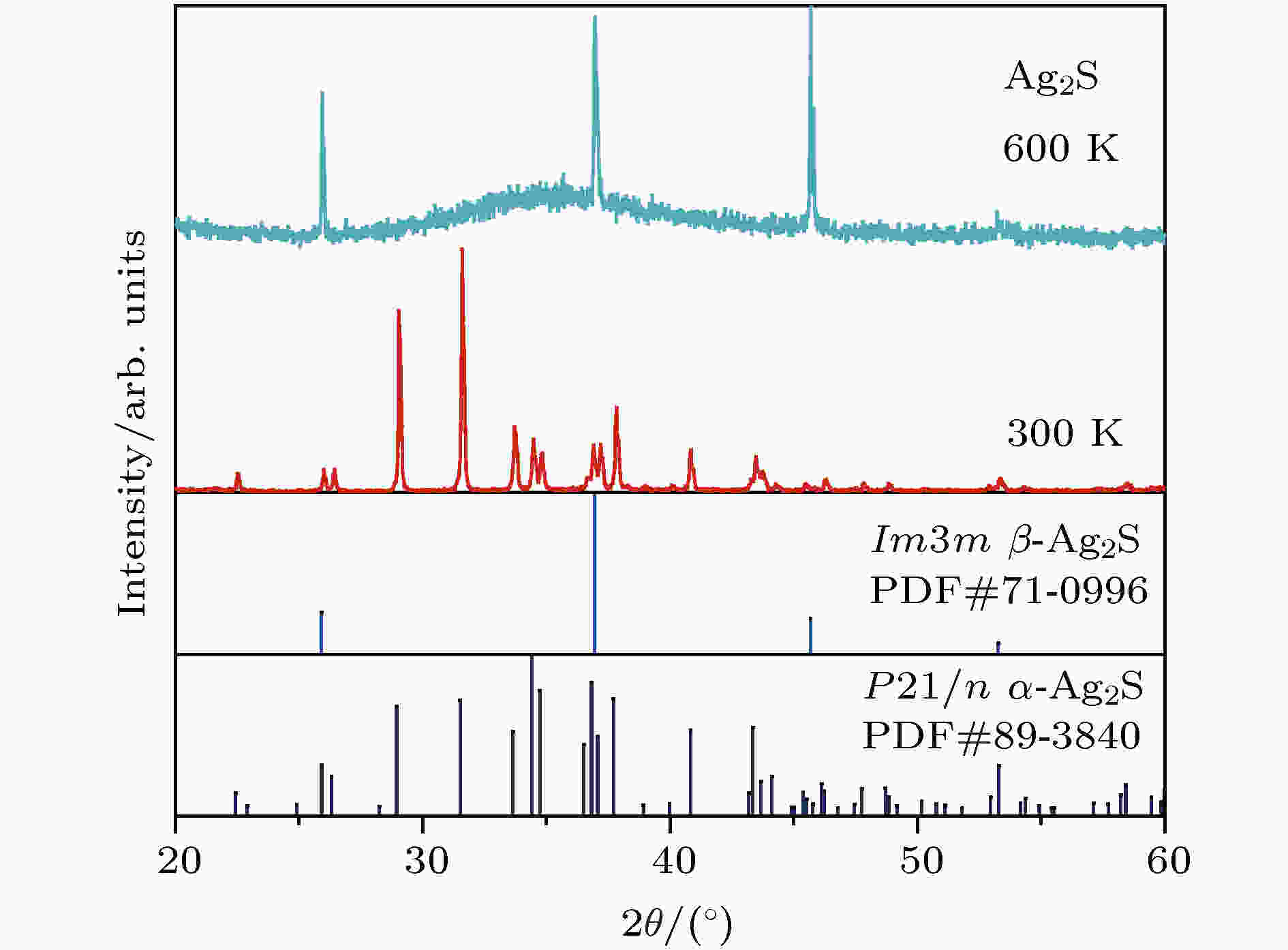
2019, 68 (9): 090201.
doi: 10.7498/aps.68.20190073
Abstract +
Recently, Ag2S superionic conductor has attracted great attention due to its metal-like ductility and deformability. In this work, the single phase Ag2S compound is fabricated by the melting-annealing method. The crystal structure, ionic conduction, and electrical and thermal transports in a temperature range of 300-600 K are systematically investigated. The monoclinic-cubic crystal structure transition occurs around 455 K for Ag2S. Significant reduction in the specific heat at constant volume below the Dulong-Petit limit is observed for Ag2S after the monoclinic-cubic phase transition, which is attributed to the liquid-like Ag ions existing inside the sulfur framework. Ag2S shows typical semiconducting-like electrical transport behavior in the whole measured temperature range. Around 455 K, the ionic conductivity, carrier concentration, carrier mobility, electrical conductivity, and Seebeck coefficient each show an abrupt change. The calculated ionic activation based on the ionic conductivity is 0.076 eV for the body centered cubic Ag2S. The calculated band gap based on the electrical conductivity decreases from 1.1 eV for the monoclinic Ag2S to 0.42 eV for the body centered cubic Ag2S. The abrupt increase of electrical conductivity after the monoclinic-cubic phase transition leads to a maximum power factor around 5 μW·cm–1·K–2 at 550 K. In the whole measured temperature range, Ag2S demonstrates an intrinsically low lattice thermal conductivity (below 0.6 W·m–1·K–1). The calculated phonon dispersion indicates that the weak chemical bonding between Ag and S is responsible for the low lattice thermal conductivity observed in the monoclinic Ag2S. Likewise, the presence of liquid-like Ag ions with low ionic activation energy is responsible for the low lattice thermal conductivity for the cubic Ag2S. Finally, the Ag2S shows the maximum thermoelectric figure of merit of 0.55 at 580 K, which is comparable to the thermoelectric figure of merit reported before in most of Ag-based thermoelectric superionic conductors.

2019, 68 (9): 090202.
doi: 10.7498/aps.68.20182302
Abstract +
As one of high capacity electrode materials of lithium ion battery, silicon suffers significant stress effects, which further affects the voltage performance of battery. In this paper, a reaction-diffusion-stress coupled model is established, and the stress induced voltage hysteresis with consideration of diffusion induced stress, surface effects and interparticle compression under potentiostatic operation are investigated. It is found that stress and stress induced voltage hysteresis are dependent on particle size. For big particles, the diffusion induced stress is dominant and further aggravates the hysteresis of both stress and the overpotential consumed by it, indicating that more energy dissipates due to the stress effects. For small particles, especially ones with radius of a few nanometers, surface effects play a more prominent role than diffusion induced stress and the stress evolves into the state of compressive stress on the whole, leading the hysteresis of overpotential to be consumed by stress shrink and making the hysteresis plot of overpotential used to drive electrochemical reaction move downward. The electrode potential first reaches a cutoff voltage and finally the capacity of lithium ion battery decays. Therefore, too large or too small particle size in the electrode can both have a negative effect on the performance of lithium ion batteries, which indicates that an optimal size of the electrode particles must be designed in terms of electrode structure. Based on the calculation, particles with around 9 nm in radius are an appropriate option for electrode design in consideration of both diffusion induced stress and surface effect. In addition, for silicon electrodes, the silicon particles inevitably squeeze each other in a charge and discharge cycle. Therefore, interparticle compression is considered in this case. In detail, interparticle compression pushes the plot of stress hysteresis to the compressive state and leads to lower lithiation capacity, which makes the overpotential plot consumed by stress move downward and accordingly the overpotential plot used to drive the electrochemical reaction move upward. Denser electrode would strengthen this effect due to higher particle compression. It is indicated that for electrode design, the minimum of porosity ratio of electrodes should be adopted because higher interparticle compressive stress would reduce the battery capacity. Our results reveal that the voltage hysteresis of lithium ion batteries is related to the active particle size and the porosity ratio of the electrode, which is of great significance for guiding one in designing the lithium ion batteries.

2019, 68 (9): 090203.
doi: 10.7498/aps.68.20190169
Abstract +
To improve the numerical accuracy and computational efficiency of solving high-dimensional nonlinear Schrödinger/Gross-Pitaevskii (NLS/GP) equation by using traditional SPH method, a high-order split-step coupled with a corrected parallel SPH (HSS-CPSPH) method is developed by applying virtual particles to the boundary. The improvements are described as follows. Firstly, the nonlinear Schrödinger equation is divided into linear derivative term and nonlinear term based on the high-order split-step method. Then, the linear derivative term is solved by extending the first-order symmetric SPH method in explicit time integration. Meanwhile, the MPI parallel technique is introduced to enhance the computational efficiency. In this work, the accuracy, convergence and the computational efficiency of the proposed method are tested by solving the NLS equations with the periodic and Dirichlet boundary conditions, and compared with the analytical solutions. Also, the singularity of solitary waves under the periodic boundary condition is accurately obtained using the proposed particle method. Subsequently, the proposed HSS-CPSPH method is used to predict the results of complex two-dimensional and three-dimensioanl GP problems which are compared with other numerical results. The phenomenon of singular sharp angle in the propagation of nonlinear solitary wave and the process of quantum vortex under Bose-Einstein condensates with external rotation are presented accurately.

2019, 68 (9): 090204.
doi: 10.7498/aps.68.20190107
Abstract +
In recent years, as the international situation about nuclear arms control changes, the multilateral international arms control cooperation including non-proliferation, nuclear terrorism and nuclear security has drawn more and more attention. As a key technology, nuclear forensics plays a significant role in the deterrence, prevention and response to illegitimate nuclear activities, for which it needs studying in depth. At present, there are plenty of researches into nuclear forensics, mostly focusing on the characterization of materials and the interpretation of data. As one of the most important aspects of nuclear forensics research, the interpretation is faced with a variety of different objects, including uranium ore, yellow cake, nuclear fuel, spent nuclear fuel and so on, among which spent nuclear fuel has attracted more and more attention due to its potential threats. In this paper, we primarily focus on the development of multivariate statistical analysis with an aim to interpret the comparative signatures of spent nuclear fuel. A database is established with uranium and plutonium isotopic compositions of spent nuclear fuel samples through simulation. These samples are of different reactor types, initial fuel enrichments and burn-ups. Subsequently, multivariate analysis, including factor analysis, discriminant analysis and regression analysis, are used to the database to validate the feasibility of the identification work. First of all, dimension reduction and visualization work is carried out to determine the possibility for classification by factor analysis. Afterwards, some known samples are assumed to be unknown to further study the possible capabilities of quantitative attribution by conducting factor analysis, including the determination of initial fuel enrichment and burn-up. To eliminate the errors in the identification work and to achieve better outcomes, the discriminant analysis and regression analysis are used to the database to assist with the identification of the reactor type, initial fuel enrichment and burn-up. As revealed by the study, factor analysis is more suitable for the dimension reduction and visualization work, disciminant analysis is more suitable for the identification of reactor type, and regression analysis is more suitable for the identification of initial fuel enrichment and burn-up. Upon the comparison drawn of the three different multivariate analysis methods, a framework for identification process is established to provide a theoretical basis and feasible scheme for the possible identification work of spent nuclear fuel with database, and facilitate the related nuclear forensics work.
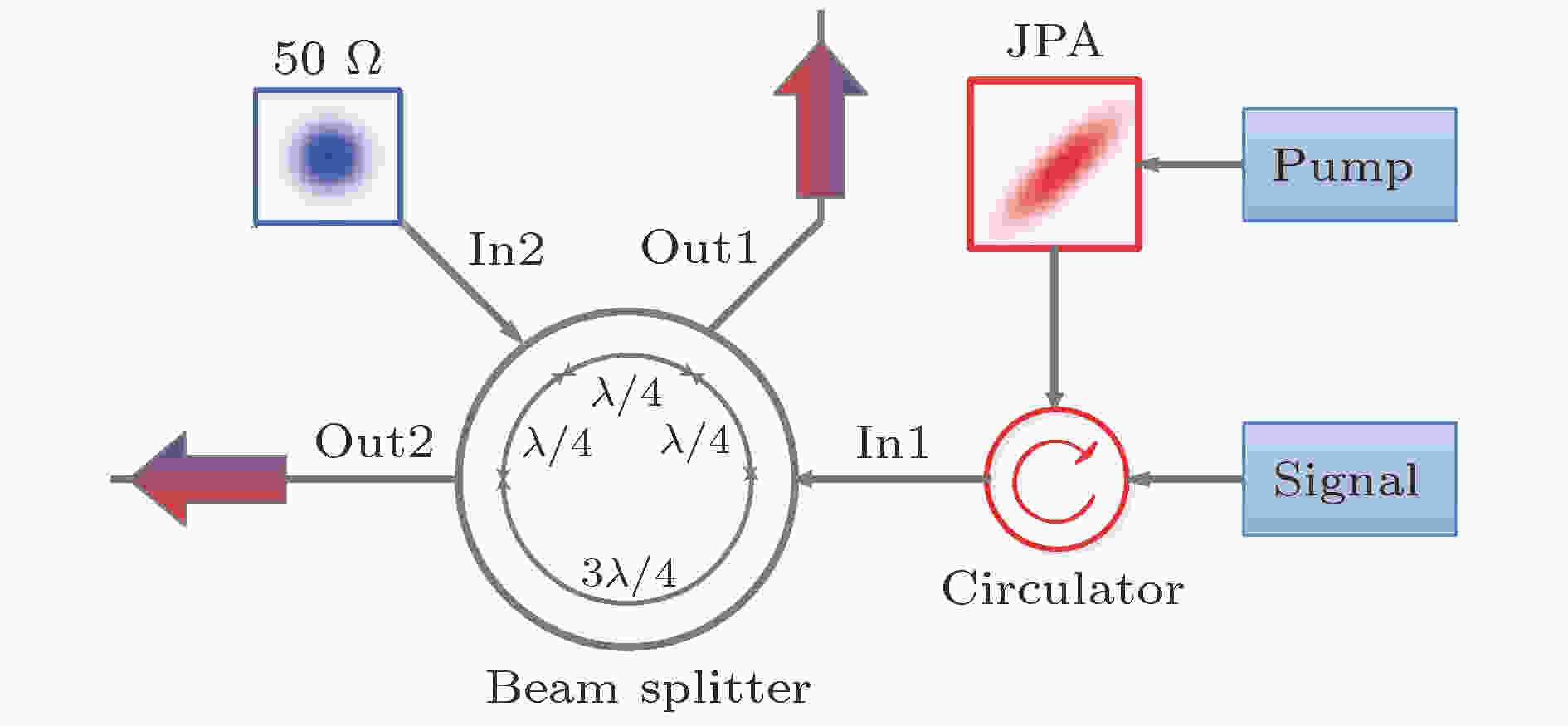
2019, 68 (9): 090301.
doi: 10.7498/aps.68.20182077
Abstract +
Quantum entanglement possesses important applications in quantum computation, quantum communication, and quantum precision measurement. It is also an important method to improve the performance of quantum radar and quantum radio navigation. However, the penetration of light wave is poor due to the high frequency, which leads to detecting limitations in bad weather. In this context, quantum entanglement in the microwave domain has been extensively studied, and it is hopeful to overcome the above-mentioned defects in quantum optics. Although the entangled microwave preparation of continuous variable is achievable at present, there exist still some problems such as poor entanglement performance, low entanglement efficiency, complex signal processing and control, which restrict the development of entangled microwave sources. In order to improve the entanglement performance in microwave domain, a squeezing-angle locking scheme based on single photon counting is proposed. First, two Josephson parametric amplifiers (JPAs) are driven respectively by two pump signals to generate two single-mode squeezed states which are uncorrelated to each other. Next, the squeezing angle difference between the two single-mode squeezed states is adjusted to 180°, and then the two signals are mixed in a superconducting 180° hybrid ring coupler for two entangled microwave outputs. The outputs are single photon detected, and the results are sent to the data processor for solution. The squeezing angle difference between the input single-mode squeezed microwaves is estimated by Bayesian criterion and compared with the target value to calculate the error. Finally, the squeezing angle correction information is fed back into the JPA pump to control the squeezing angle of the single-mode squeezed microwave of the JPA output as well as the relative squeezing angle to reach the target value. Thus, the dual-path entangled microwave with the optimal entanglement performance is output. Comparing with the existing entangled microwave preparation schemes, a single photon counter is utilized in the scheme of this paper, which leads to a detection efficiency of 90%. In addition, the Bayesian criterion is used to estimate the output result, and the theoretical precision reaches the quantum Cramer-Rao lower bound. Meanwhile, the introduced noise level and operation difficulty are reduced, which greatly improves the property of dual-path entangled microwave preparation.
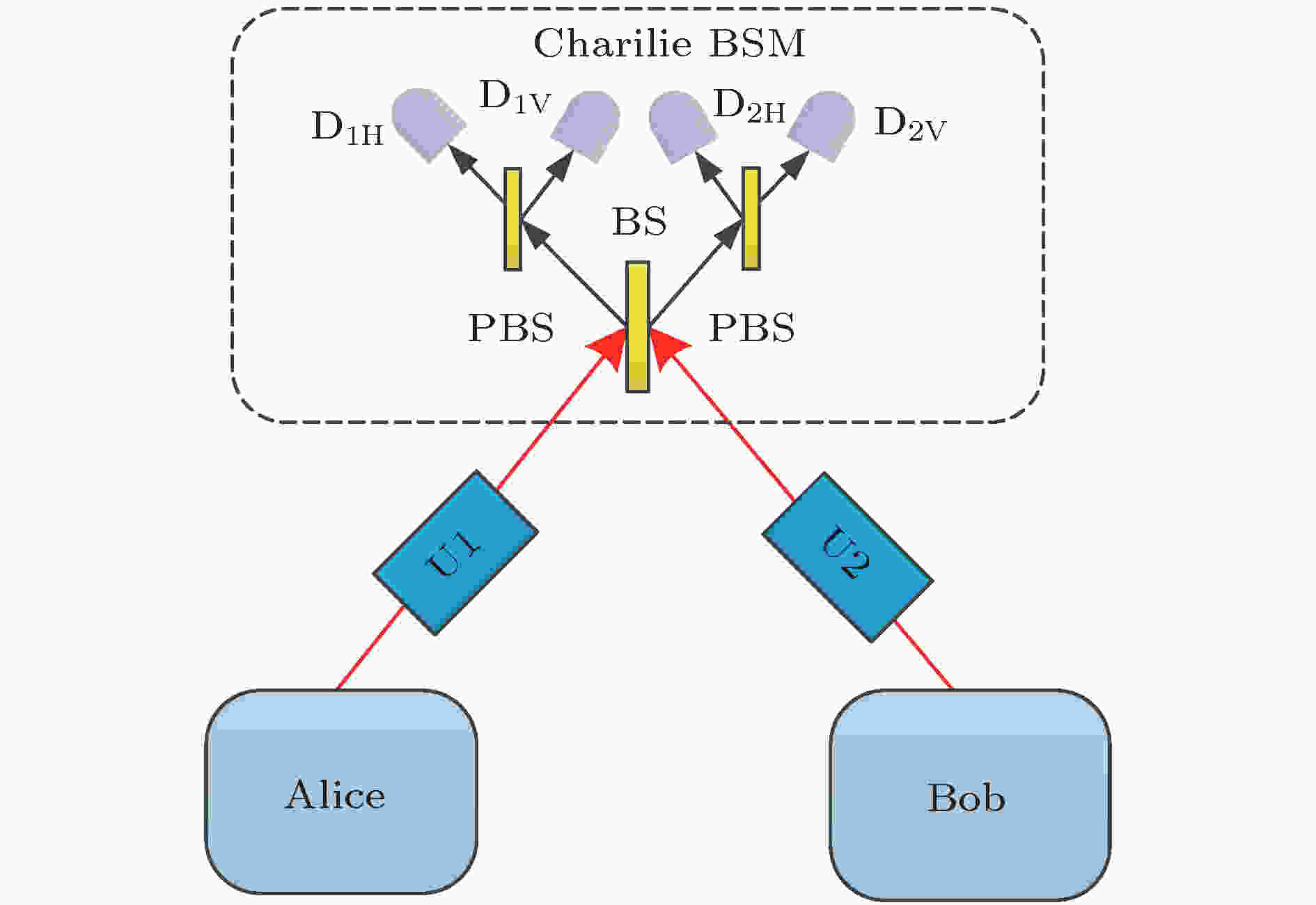
2019, 68 (9): 090302.
doi: 10.7498/aps.68.20182130
Abstract +
Free-space quantum key distribution (QKD) allows two distant parties to share secret keys with information-theoretic security, which can pave the way for satellite-ground quantum communication to set up a global network for sharing secret message. However, free-space channels in the presence of atmospheric turbulence are affected by losses and fluctuating transmissivity which further affect the quantum bit error rate and the secure key rate. To implement free-space QKD, it is indispensable to study the effect of atmospheric turbulence. Different models have been used to describe the probability distribution for channel transmission coefficient under atmospheric turbulence, including the log-normal distribution and K distribution. In this paper, we focus on free space measurement-device-independent quantum key distribution (MDI-QKD) under K-distributed strong atmospheric turbulence. The MDI-QKD can close all loopholes on detection and achieve a similar performance to QKD, relying on time-reversed version of entanglement-based QKD protocol. Threshold post-selection method is adopted to restrain detrimental effects of the atmospheric turbulence, which is based on the selection of the intervals with higher channel transmissivity. By combining the general MDI-QKD system model with this method, we present a framework for the optimal choice of threshold. Our simulation result shows that the optimal threshold is dependent on the turbulence intensity and expected channel loss. Furthermore, compared with the original MDI-QKD protocols, the proposed protocol with threshold post-selection method can acquire a considerable better performance in key rate, especially in regions of high turbulence and high loss. What is more, this is instructive to the building of a practical free-space MDI-QKD system with better performance.
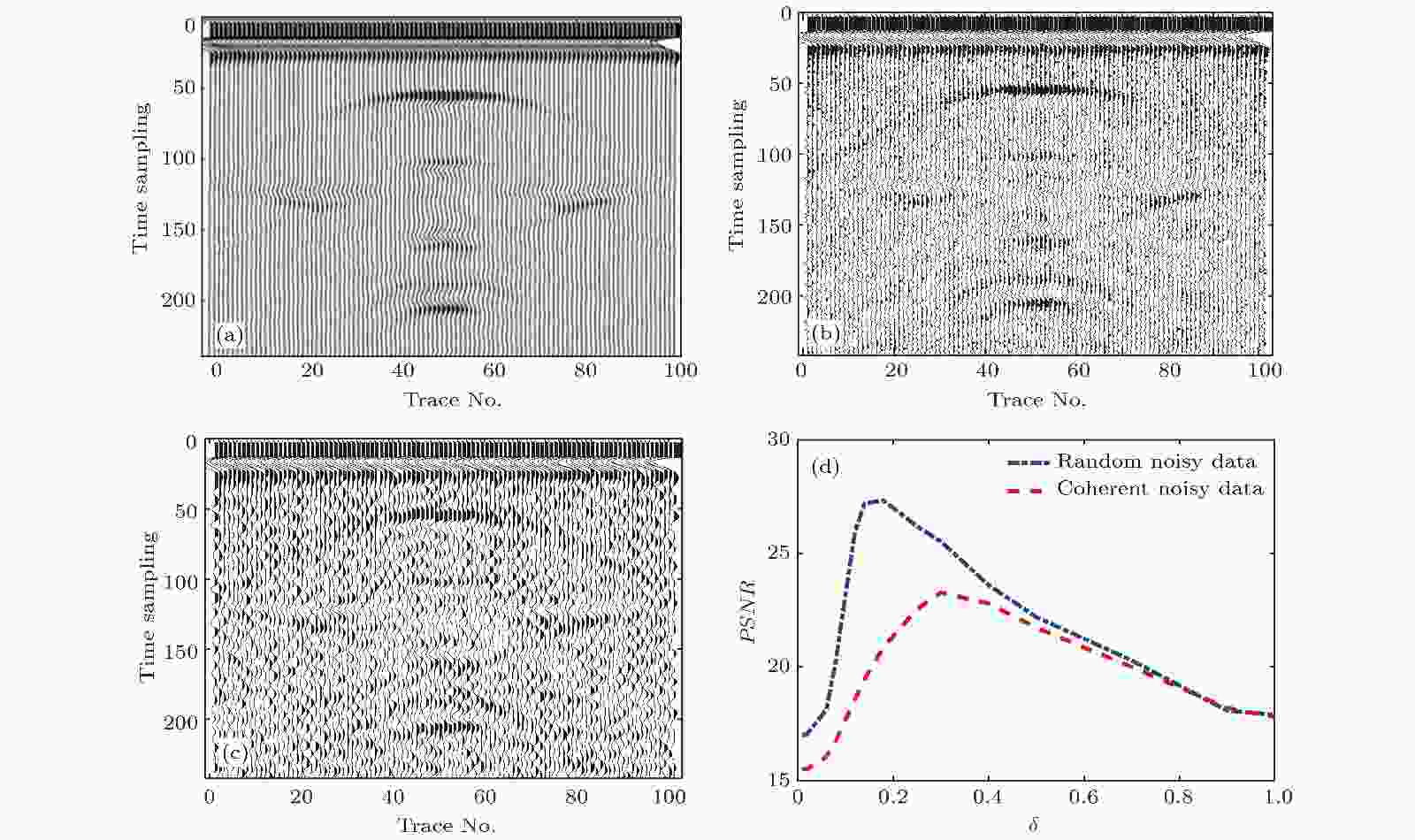
2019, 68 (9): 090501.
doi: 10.7498/aps.68.20182061
Abstract +
Nonlinear and non-stationary ground penetrating radar (GPR) data for geophysics exploration are often mixed with various complex noise sources, such as random and coherent noise. Those complex noise sources are introduced by the acquisition system and other sources of measurement uncertainty. The data sets which are contaminated by the above noises have a serious influence on the accurate extraction of weak reflected signals and the effective identification of diffracted wave hyperbolic coaxial characteristics. The ignorance of the influence of noise will cause great errors in the interpretation of GPR data and the subsequent migration imaging with full waveform. The curvelet transform not only is related to position and frequency as compared with the wavelet transform, but also is controlled by the translation angle. With such a unique advantage, curvelets are used for ground roll whitening, coherent noise denoising and separation of overlapping events. The traditional curvelet transform denoising with a hard threshold function needs to give a reasonable threshold function control coefficient according to the noise level of GPR data. As a result, an appropriate choice of a hard threshold is a basic requirement, and this presents a challenging task in curvelet denoising. To overcome these shortcomings, an self-adaptive threshold function for GPR data denoising with curve transform is proposed in this paper. For detailing the reasonable control coefficient of the threshold function, the complex block threshold function algorithm is used to analyze the distribution of peak-signal-to-noise ratio value of the noisy synthetic GPR data contaminated with random and coherent noise by using the traditional threshold function curvelet transform. Based on the high order statistical theory, the accuracy distribution of the curvelet coefficient for useful signals in scale and rotation direction are correlatively stacked and determined by using the statistical self-adaptive function. And then the threshold range of noise removal components is given by the statistical self-adaptive function. The effectiveness of the proposed denoising algorithm for the noisy synthetic contaminated with different types of noise (i.e., Gaussian random and coherent), and field GPR data is demonstrated by comparing the denoising results via curvelet transform with those from traditional thresholding function. The presented denoising results by the statistical self-adaptive function is helpful and instructive for the accurate inference and interpretation of complex GPR data.

COVER ARTICLE
2019, 68 (9): 090701.
doi: 10.7498/aps.68.20190030
Abstract +
Magnetometry has already been widely used in mineral exploration, medical exploration and precision measurement physics. One is trying to improve the sensitivity of the magnetometer. One of the most widely used magnetometers is based on the Bell-Bloom structure, which can be realized by modulating the pump light. The sensitivity of the Bell-Bloom magnetometer is determined by the magnetic resonance linewidth (MRL) and the signal-to-noise under the condition of magnetic resonance (SNR). Both are affected by the pump intensity and the relaxation rate of the atoms. In order to achieve a higher sensitivity, how these factors affect the magnetic field measurement should be analyzed. In this paper, the influence of the pump light on the sensitivity of the linearly polarized Bell-Bloom magnetometer is investigated based on the Bloch equation with amplitude modulated pump beam and the rate equations with spin relaxation. The rate equations are obtained from the Liouville equation, and the theoretical analysis is based on the cesium. The pump beam is linearly polarized and is resonant to D1 transition of cesium. Both the direct pump (pump frequency is resonant to ${6^2}{{\rm{S}}_{1/2}}\;F = 4$ −${6^2}{{\rm{P}}_{1/2}}\;F' = 3$ transition) and the indirect pump (pump frequency is resonant to ${6^2}{{\rm{S}}_{1/2}}\;F = 3 $ −${6^2}{{\rm{P}}_{1/2}}\;F' = 4$ transition) are analyzed. The experiment is performed based on a 20-mm cube cesium vapour cell with 20-Torr helium as buffer gas. The linearly polarized probe beam is tuned to resonance to cesium D2 transition ${6^2}{{\rm{S}}_{1/2}}\;F = 4$ −$ {6^2}{{\rm{P}}_{3/2}}\;F' = 5$ , and the intensity of the probe is 0.2 W/m2. The spectra of magnetic resonance are measured by using the lock-in detection with a scanning of the modulation frequency. Then the sensitivity can be obtained by measuring MRL and SNR. The experimental results show that the sensitivity and the pump intensity are related nonlinearly, which is coincident with theoretical result. Higher sensitivity can be obtained under the condition of indirect pump. In addition, the effect of atomic spin relaxation on sensitivity is also analyzed with the indirect pump beam. This work clarifies the dynamics of the Bell-Bloom magnetometer to some extent. The highest sensitivity obtained is $31.7\;{\rm{pT}}/\sqrt {{\rm{Hz}}} $ in our experiment, which can be optimized by using other kinds of vapour cells and different measuring methods.
NUCLEAR PHYSICS
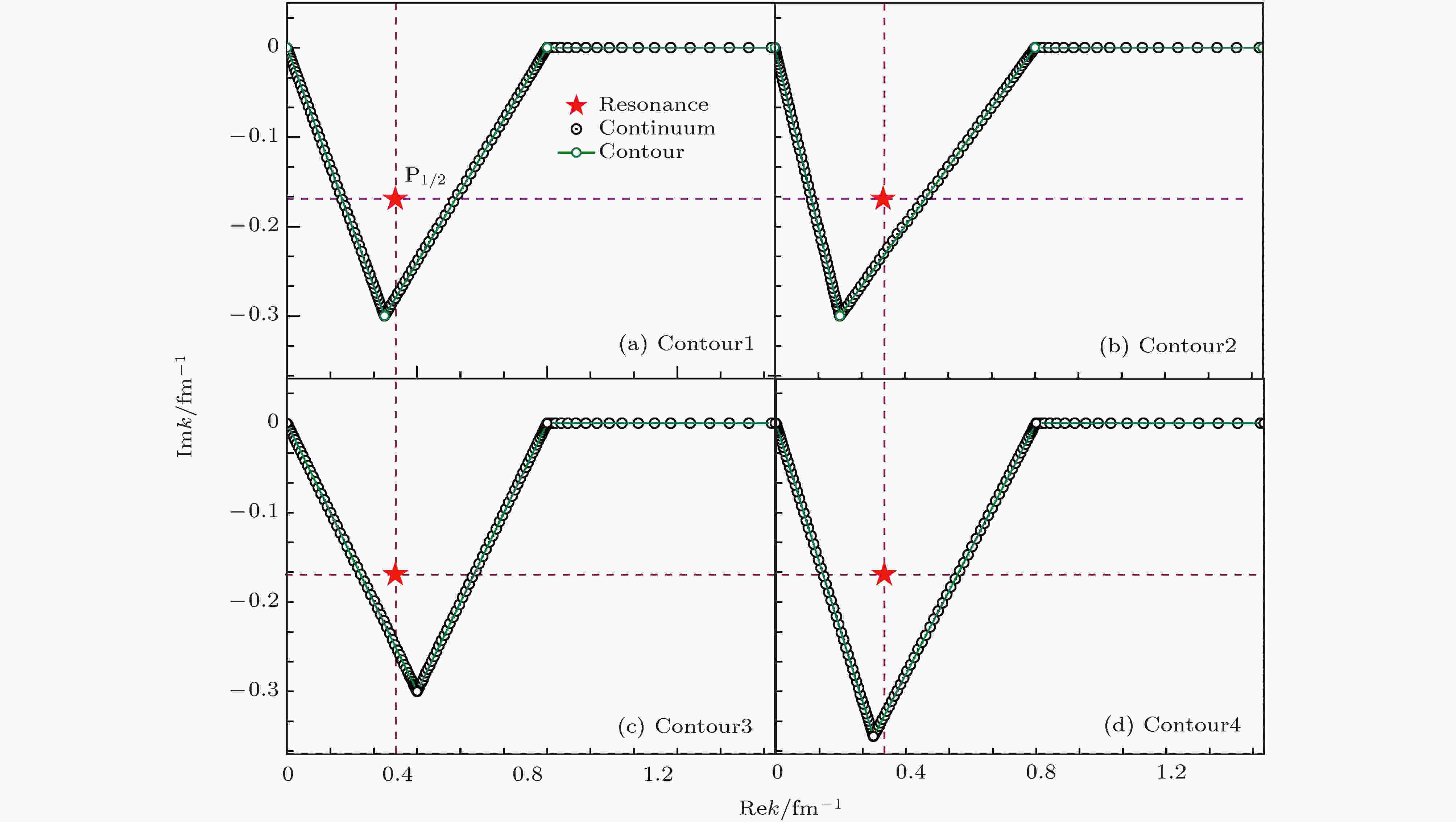
2019, 68 (9): 092101.
doi: 10.7498/aps.68.20182197
Abstract +
Nuclear scattering is a very important physical phenomenon in which the resonance state plays an important role. In order to study the two-body system n-α scattering, Green’s function is introduced under the complex momentum representation, so the complex momentum representation-Green’s function approach is established. This method is used to study the elastic scattering of n-α system. By extracting the resonances, it is found that the contributions of resonances in continuum level density, phase shift, and cross section are more important. In the case without introducing any non-physical parameters, it is very helpful to understand the resonant states and the non-resonance continuum states by analyzing the data of scattering states. In this work, we mainly study the p-wave scattering with the orbital angular momentum l = 1, where P1/2 is a wide resonance state and P3/2 is narrow resonance state. The study shows that the sharp resonance peak of p-wave scattering gives rather broad distribution to the scattering phase shift and the cross section of the n-α system. By comparison, we can see that the theoretical calculation results and experimental data are in good consistence.
ATOMIC AND MOLECULAR PHYSICS
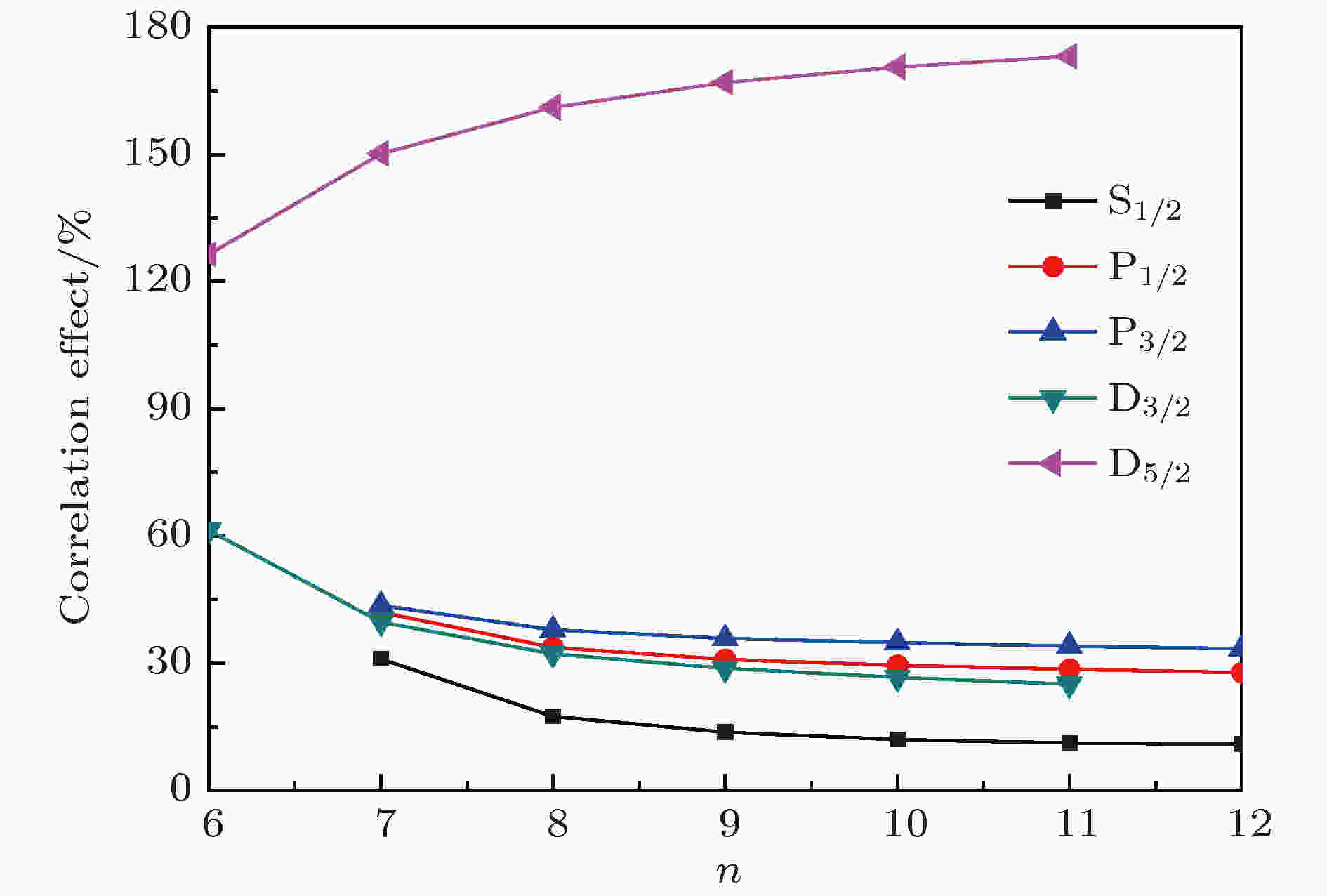
2019, 68 (9): 093101.
doi: 10.7498/aps.68.20190113
Abstract +
As the heaviest atom in alkali-metal elements, Fr atom has been regarded as a candidate for the search of the permanent electric dipole moment of the electron and of parity-nonconservation effects. Accurate knowledge of Fr atomic properties is of great interest. In this work, we use a relativistic coupled-cluster method to calculate the magnetic dipole hyperfine structure constants for nS (n = 7-12), nP (n = 7-12) and nD (n = 6-11) states of 212Fr. A finite B-spline basis set is used to expand the Dirac radial function, including completely the single and double excitation in correlation calculation. Our results are compared with available theoretical and experimental values. The comparison shows that our method can offer accurate calculation of magnetic dipole hyperfine structure constant. For 7P state the differences between our results and experimental values are within 1%. The magnetic dipole hyperfine structure constants for 12S, nP (n = 9-12) and nD (n = 10-11) states are reported for the first time, which are very useful as benchmarks for experimental measurements and calculations by other theoretical methods of these quantities. In the relativistic coupled-cluster theoretical framework, we study the electron correlation effect on hyperfine-structure constant A for the S, P, and D states of Fr. We observe that the electron correlation effect is very important for hyperfine-structure constant properties. The D state has a considerable correlation effect. At the same time, we also investigate contribution trends of individual electron correlation effects involving direct, core-polarization and pair-correlation ones in S, P, and D Rydberg series. It is found that the dominant contributions for the S1/2, P1/2,3/2 and nD3/2 (n = 7-11) states are to from the direct effect; however, the dominant contributions for the 6D3/2, and nD5/2 (n = 6-11) states are due to the pair-correlation and the core-polarization, respectively. For D5/2 states, there is very strong cancellation among these individual correlation effects. The knowledge of these correlation trends is useful for studying the permanent electric dipole moment and parity-nonconservation effect of Fr in future. Moreover, the magnetic dipole moment $ {\mu}$ for each of isotopes 207−213,220−228Fr is determined by combining with experimental values for magnetic dipole hyperfine structure constant of 7P state. For each of isotope 207−213Fr, our magnetic dipole moment $ {\mu}$ is perfectly consistent with the experimental value, and our uncertainties are twice smaller than those in the experiments . For each of isotope 220−228Fr, our magnetic dipole moment $ {\mu}$ has a larger uncertainty, but is still in agreement with the experimental magnetic dipole moment $ {\mu}$ .

EDITOR'S SUGGESTION
2019, 68 (9): 093701.
doi: 10.7498/aps.68.20182294
Abstract +
The frequency shift caused by blackbody radiation is one of the dominant corrections to the evaluation of the optical lattice clock. The frequency shift of blackbody radiation is closely related to the dynamic and static correction factor, ambient temperature and atomic polarizability. The blackbody radiation shift is mainly affected by ambient temperature. During the normal operation of the strontium atom optical lattice clock, the experimental environment and other heat sources around the vacuum cavity have complicated the environment around the vacuum cavity, resulting in the fact that the external surface temperature of the vacuum cavity does not truly reflect the temperature change of the vacuum cavity. For the strontium atomic optical clock experimental apparatus of the National Time Service Center, the uncertainty and correctionof the blackbody radiation frequency shift are evaluated by the theoretical analysis, measurement of the temperature of the vacuum cavity outer surface, and software simulation. Among them, the frequency shift of black body radiation caused by strontium atom furnace, sapphire heating window, room temperature radiation entering into the vacuum cavity through the window plate, and the thermal radiation at the atomic group caused by Zeeman reducer are analyzed. Five temperature measuring points are set on the external surface of the vacuum chamber, and the temperature changes on the external surface of the vacuum chamber are monitored in real time by using the calibrated platinum resistance temperature sensor while the system is running normally. We obtain the average temperature of the five temperature measuring points. The model of vacuum cavity is established by using the SolidWorks. The method of finite element analysis is used to simulate the variation of the temperature around atom samples. We also obtain the temperature distribution around the atomic groups in the vacuum cavity. The result shows that the temperature around atoms varies with the temperature of the vacuum cavity. When the temperature of the ambient temperature changes 0.72 K, the fluctuation of the temperature around the atoms is 0.34 K. Finally, the total correction of blackbody radiation of the system is evaluated to be –2.13(1) Hz, and the correction uncertainty is about 2.4 × 10–17.
ELECTROMAGNETISM, OPTICS, ACOUSTICS, HEAT TRANSFER, CLASSICAL MECHANICS, AND FLUID DYNAMICS

2019, 68 (9): 094101.
doi: 10.7498/aps.68.20182291
Abstract +
Micro-structured targets have been widely used in the interaction between ultra-intense laser and target, aiming at improving the electron accelerating efficiency. In this paper, we perform two-dimensional particle-in-cell (PIC) simulations to study the interaction of the ultra-intense laser pulse with the micro-structured foam-attached target (the foam is composed of low density bubbles and high density interfaces between the bubbles). It is found that at the beginning of the laser-plasma interaction, the fast electrons accelerated at the front surface of the foam freely propagate into the target and drive a return current of cold background electrons. These cold background electrons are restricted to propagate along the interfaces between the bubbles in the foam due to the self-generated large sheath field. As a result, small current filaments are generated in the foam, which then leads to the generation of randomly distributed megagauss magnetic field in the foam layer. This quasistatic magnetic field then acts as an energy-selective " magnetic barrier”: the low-energy electrons are reflected back into the laser acceleration region while the high-energy electrons can penetrate through it. If the reflected electrons enter into the laser field with proper phases, they can be further accelerated to higher energy through cooperative actions of the ultra-intense laser pulse and the sheath field generated due to plasma expansion at the target surface. Our simulation results show that many of the laser accelerated low-energy electrons can be reflected back and accelerated several times until they gain enough energy to penetrate through the magnetic barrier. This is termed the " multiple acceleration mechanism”. Due to this mechanism, the electron acceleration efficiency in the foam-coated target with a thickness of several microns is significantly enhanced in comparison with that in the plane target. This enhancement in the electron acceleration efficiency will be beneficial to many important applications such as the fast ignition. Additionally, foam-coated targets with different bubble radii and layer thickness are also studied, and it is found that the yield of the high energy electrons increases with the radius of bubble size more efficiently than with the bubble thickness. In order to understand the physics more clearly, a single particle model is developed to analyze the simulation results.

2019, 68 (9): 094202.
doi: 10.7498/aps.68.20182269
Abstract +
In aero optics, the linking equation proposed by Sutton is an important equation which can link the fluid-mechanic statistical parameters to the statistical optical degradation parameters. However, in the application of simplified linking equation (SLE) to subsonic flowfields, the weighting function is often ignored. The supersonic mixing layer flowfield is generated in the supersonic wind tunnel. The nanoparticle-based planar laser scattering technology is used to obtain the density field of flowfield. The optics errors between supersonic mixing layer wave-front variances calculated from the SLE and the generalized linking equation are analyzed. The results indicate the validity of using the SLE to estimate the wave-front variance of supersonic mixing layer flowfield. Moreover, the SLE with weighting function has better fitting accuracy than the SLE without weighting function. The weighting function for the application of SLE to the high correlated regions in the supersonic mixing layer is necessary.

2019, 68 (9): 094203.
doi: 10.7498/aps.68.20182052
Abstract +
Clouds, aerosols and atmospheric molecules are major components of the atmosphere. In the fields of atmospheric physics such as target detection, wireless optical communication and remote sensing, these atmospheric components have a strong attenuation effect on laser transmission. Based on the successive scattering method for solving the radiative transfer equation, the laser transmission model between airborne wireless optical communication terminal and ground-to-air unmanned aerial vehicle (UAV) target in complex atmospheric background is established in this paper. Considering the fact that cirrus cloud, atmospheric molecules and aerosols exist in the real atmospheric background, the variations of direct transmission power, first-order scattering transmission power of 1.55 μm laser emitted by the airborne wireless optical communication terminal with UAV target height are calculated numerically under complex atmospheric background. The effects of the aircraft located at different locations, effective radius of ice crystal particles in cirrus cloud, as well as the horizontal distance between the aircraft and UAV target on received laser transmission power are also analyzed. In the first three examples (i.e., aircraft is above, below, and inside cirrus cloud), laser direct transmission power (LDTP) is much larger than first-order scattering transmission power (FSTP); when the UAV target rises into the cloud, the FSTP is significantly enhanced as a result of the effect of diffraction light. The fourth example is for calculating the variations of LDTP and FSTP with UAV target height for different effective radii of ice crystals. The results show that the LDTP decreases with the increase of effective radius, whereas the FSTP presents an opposite scenario. The fifth example is for calculating the variations of LDTP and FSTP with UAV target height for different horizontal distances. The results show that the LDTP and FSTP decrease with the increase of the horizontal distance, which is obviously realistic. In summary, it is concluded that the laser transmitted power through cirrus clouds is strongly dependent on aircraft position: above, below, or inside cirrus cloud; the horizontal distance between the aircraft and UVA target, and effective radii of ice crystals have great influences on LDTP and FSTP. Compared with the atmosphere above the clouds, the molecules and aerosols below the clouds make the laser power have a strong attenuation. The results given in this paper provide theoretical support for further studying the laser communication experiment in ground-to-air links, UAV formation, command and networking technology in complex atmospheric background.
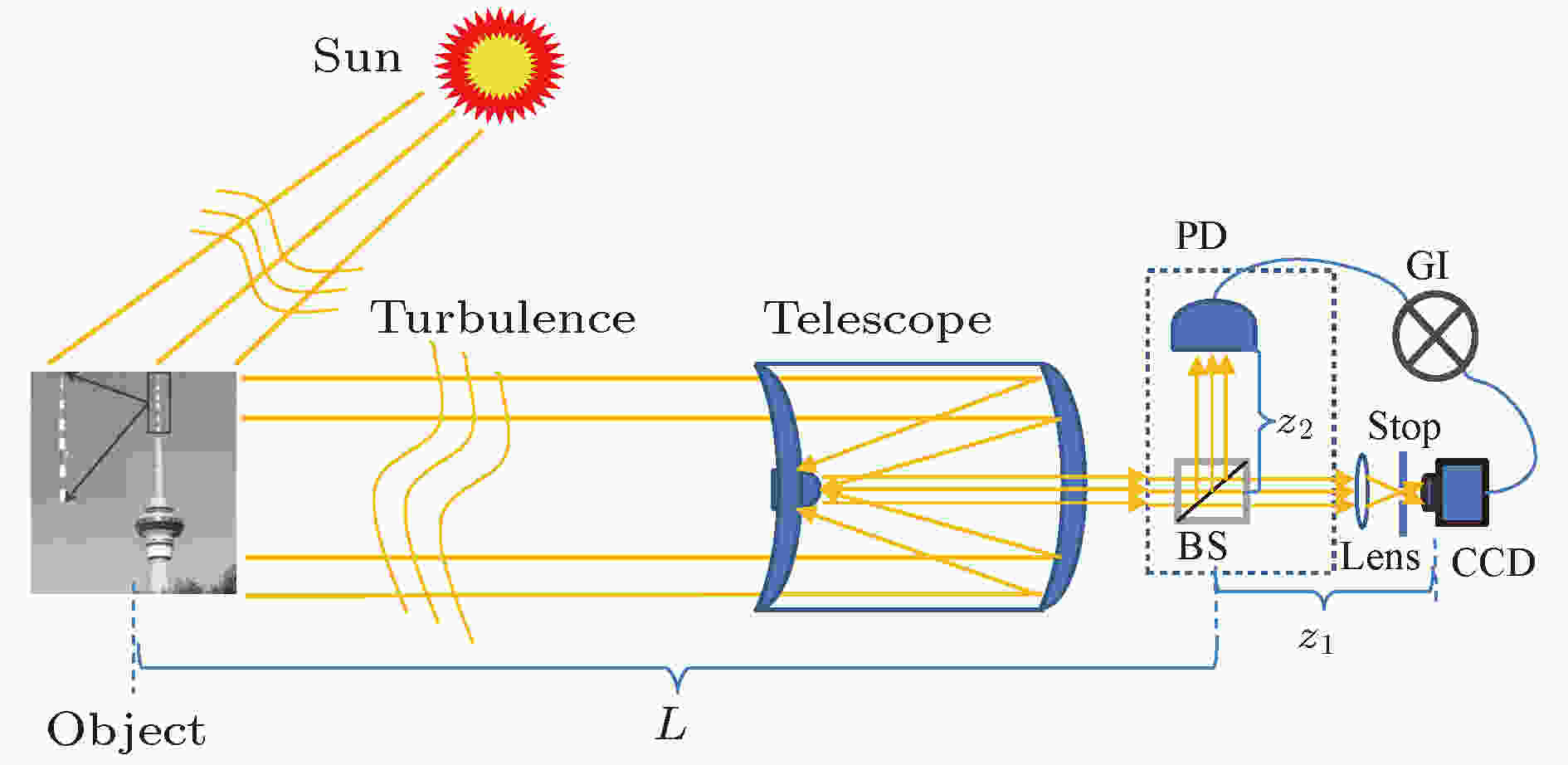
2019, 68 (9): 094204.
doi: 10.7498/aps.68.20182181
Abstract +
Since its first experimental demonstration in 1995, ghost imaging has attracted a great deal of attention due to its potential applications. In Yanhua Shih’s paper (Meyers R E, Deacon K S, Shih Y H 2011 Appl. Phys. Lett. 98 111115; Meyers R E, Deacon K S, Shih Y H 2012 Appl. Phys. Lett. 100 131114), he pointed out that " one of the useful features is the turbulence insensitivity of thermal light ghost imaging, i.e., atmospheric turbulence would not have any influence on the ghost images of sunlight”. However, in Jeffrey H. Shapiro’s view (Shapiro J H 2012 arXiv:1201.4513 [quant-ph]), lens-less pseudo-thermal ghost imaging is not immune to spatial resolution loss from the presence of atmospheric turbulence along the propagation paths, unless the source diameter is less than the source-plane turbulence coherence length. In the present paper, we find that the second order self-correlation of sunlight intensity is the case that can be satisfied with both theories of Shih and Shapiro. In this paper, the second order self-correlation of sunlight intensity (the intensity variance of the images acquired by the CCD camera), rather than the total intensity correlation between images and bucket detector signals (the traditional ghost imaging method), is calculated to recover the high-quality images in turbulent atmosphere under a few hundred measurements. Inspired by Boyd’s paper, titled " thermal ghost imaging with averaged speckle patterns” (Zerom P, Shi Z, O’Sullivan M N, Chan K W C, Krogstad M, Shapiro J H, Boyd R W 2012 Phys. Rev. A 86 063817), turbulence insensitivity of sunlight ghost imaging is demonstrated both theoretically and experimentally in this article. It is found that thermal ghost imaging system whose coherence time need not to be controlled to match the speed of the detectors, ghost imaging with sunlight, which has always been considered intriguing and highly desirable, now is realizable. We present theoretical and experimental results showing that a sunlight self-correlation ghost imaging system can produce high-quality images even when it uses an slow detector and passes through the turbulence near ground, as long as the signal variation is predominantly caused by the fluctuation of the sunlight intensity rather than other noise sources. Our scheme can also be used to improve the image quality in other wave bands such as infrared and ultraviolet, in the case where an poor image quality results from the turbulence or other random disturbances on the wavefront.

2019, 68 (9): 094205.
doi: 10.7498/aps.68.20181837
Abstract +
Entanglement manipulation in various systems is one of the important problems in quantum information science. In this paper, the phase sensitivity and entanglement enhancement of the cascade four-wave mixing of hot atomic steam are studied. The results show that the quantum entanglement of the probe light and the conjugate light output at the second level of the cascade four-wave mixing process is significantly stronger than that at the first level, and the maximum increment can reach more than 5 dB, and the perfect entanglement can be achieved by increasing the intensity factor. The relations of quantum correlation type and the size of the entanglement with the pump phase and the nonlinear intensity factor are also discussed in this work. The results show that because of the enhancement of entanglement and the sensitivity of entanglement type to pump phase, the light field noise characteristics can be changed by controlling the phase and intensity factors thus realize the enhancement of entanglement between the probe and coupling light and the quantum manipulation of entanglement extent and quantum entanglement type. The theoretical study is of important significance for guiding the experimental implementation of optical parameter manipulation of entanglement enhancement, compression angle and compression degree of two-mode compression state.
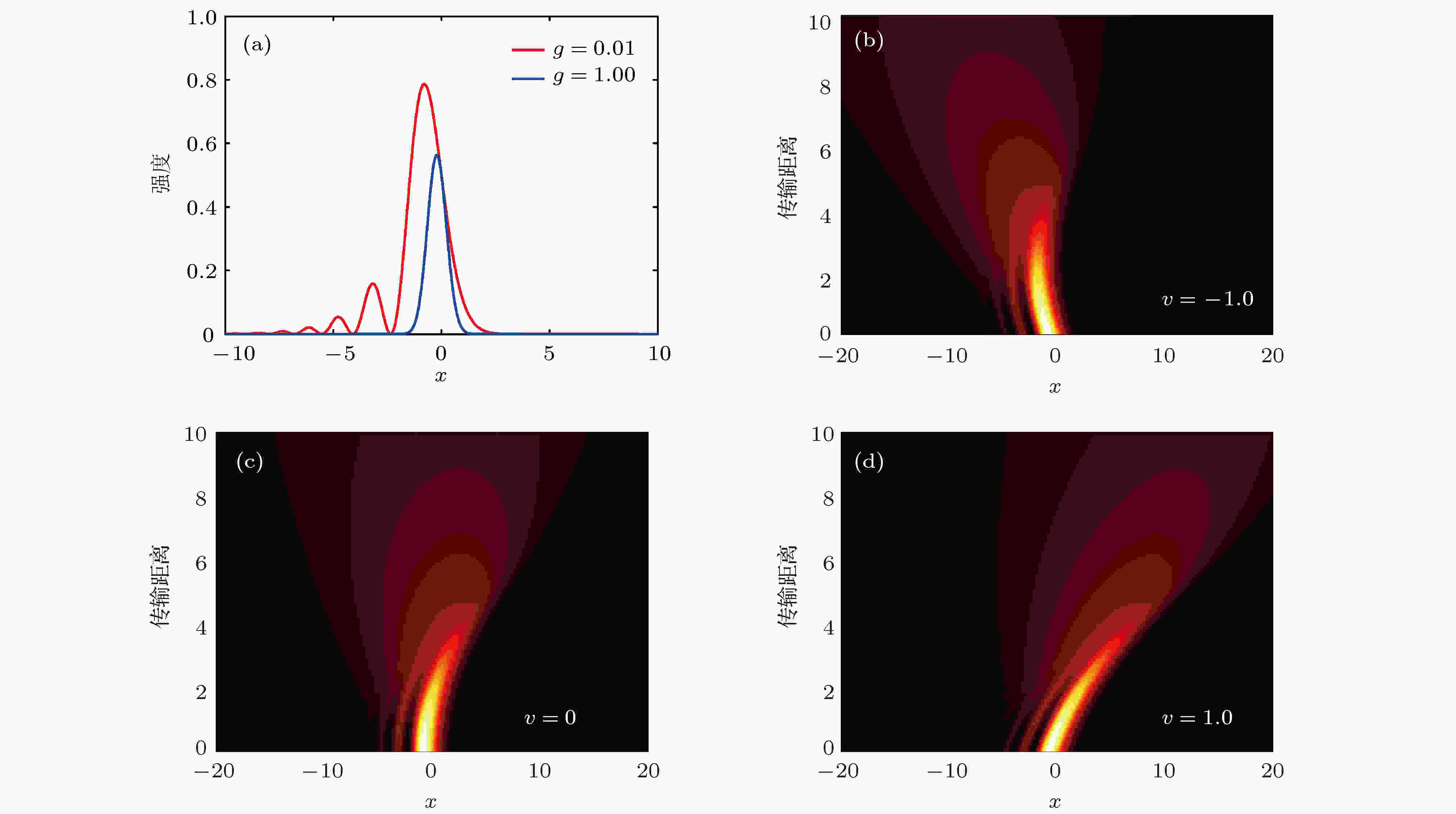
2019, 68 (9): 094206.
doi: 10.7498/aps.68.20190042
Abstract +
An investigation of control on the interaction of Airy-Gaussian beams (AiGBs) in cubic focusing and quintic defocusing competing nonlinear medium is performed by the split-step Fourier transform method. When the initial launch angle v is zero, two in-phase AiGBs attract each other and the breathing soliton with decaying period or soliton with invariant intensity can form in the case of weaker quintic defocusing nonlinearity. However, the interaction between two in-phase AiGBs under stronger quintic defocusing causes the average width of the breathing soliton to increase and even the beam bifurcation to occur, leading to the generation of soliton pairs. For the out-of-phase case, they repel each other, and the repulsive force increases monotonically with the increase of the quintic defocusing nonlinearity. When the initial launch angle for each of AiGBs is not zero, mutual attraction and repulsion can be exhibited during their interactions by adjusting the sign of v and the interval d. For the in-phase case, if v < 0 and d < 0 or v > 0 and d > 0, there are strong repulsive force and weak attraction between the two AiGBs, resulting in the formation of soliton pairs, and with the decrease of the interval, the attraction becomes greater. When the interval is small enough, the overlapping of the light field can make the nonlinear effect identical to the diffraction effect, the attraction between the two AiGBs increases, while the repulsion force is almost zero, and then a single breathing soliton can be generated in the center of the two AiGBs. If v < 0 and d > 0 (big enough) or v > 0 and d < 0, the constructive interference between two AiGBs causes the autofocusing beams first to be generated, then to repel each other, and the soliton pairs can form. For the out-of-phase case, if v < 0 and d < 0 or v > 0 and d > 0, the repulsion between the two AiGBs becomes bigger, and the repulsion increases with |v| monotonically. If v < 0 and d > 0 or v > 0 and d < 0, the elastic collision between the two AiGBs shows the phenomenon: first attracting and then repelling mutually. When both v and d are small enough, soliton pairs cannot form due to the unbalance between the strong diffraction effect and weaker nonlinear effect induced by the destructive interference.

2019, 68 (9): 094301.
doi: 10.7498/aps.68.20190183
Abstract +
Acoustic inversion of sediment parameters in muddy bottom environment has received much attention in the field of underwater acoustics. In shallow water, when there is a low-speed layer of unconsolidated sediment, such as mud in which the sound speed is lower than that of the sea water, on the top of a high-speed bottom, the transmission losses at different frequencies will increase periodically under the condition of small grazing angles. Based on this phenomenon, an acoustic inversion method of seabed parameters for low speed sediments is proposed. Firstly, the analytical expressions between the frequency interval of the transmission loss (TL) periodical increasing and geoacoustic parameters, including the sound speed and the thickness of sediment layer and the sound speed of seawater near the bottom, are derived under the condition of small grazing angles. Secondly, using the broadband sound propagation signals received under the thermocline in the 2002 summer acoustic experiment conducted in the Yellow Sea, the TL at small grazing angles increases periodically with the frequency, and it is determined that the sediment of this sea area is a low-speed sediment. Then, taking the analytical expression as the constraint condition and combining with Hamilton's empirical formula, the sound speed, density, thickness of sediment layer and the sound speed and density of the seabed are inverted by matched field processing. Finally, the bottom attenuation coefficients at different frequencies are inverted by using the long-range TL, and the linear relationship between the attenuation coefficients and the frequencies is obtained. The equivalence between the two different bottom models is discussed in the end. The inversion results can provide seabed parameters for the study and application of the sound propagation law in shallow water with a low-speed sediment.

2019, 68 (9): 094701.
doi: 10.7498/aps.68.20181956
Abstract +
Flow system on a nano scale, as an effective and economic system, has been widely employed. While on a macroscopic scale, for the non-slip boundary, the velocity of the fluid at the surface is assumed to be consistent with the surface. This approximation may become invalid on a smaller length scale pertinent to the operation of microfluid devices. The interface slip effect has a significant influence on the flow because of its higher ratio of surface to volume. In this paper, the Poiseuille flow, which is composed of two infinite parallel asymmetric walls, is studied by the molecular dynamics method. The influence of wall roughness and surface wettability of channel on fluid flow in the channel are analyzed. The results show that the asymmetric upper and lower wall can lead to an asymmetric distribution of flow parameters. The change of wall roughness and wettability would affect the flow characteristics of fluid atoms near the wall. Due to the influence of wall grooves, the number density distribution near the rough wall is lower than that on the smooth wall side. As the rib height and wall wettability increase, the number density of fluid atoms in the groove increases gradually, and the change of the rib spacing does not substantially affect the number density distribution of fluid atoms near the rough wall. For different structure types of walls, the real solid-liquid boundary positions are determined by simulating the velocity field distribution in the channel under both Couette flow and Poiseuille flow, which can help us to better analyze the interface slip effect. The variation of wall roughness and wettability can affect the position of the solid-liquid interface. The change of rib height and wettability can greatly influence the velocity distribution in channel, and the position of the solid-liquid boundary as well. Conversely, the rib spacing has a less effect on the boundary position. The difference in boundary position can affect the interface slip effect. We can find the slip velocity and the slip length on one side of the rough wall to be smaller than those on the smooth wall side, and as the rib height and wall wettability increase, the slip velocity and the slip length significantly decrease near the rough wall side. The effect of rib spacing on fluid flow is trivial, and the interface slip velocity and length are relatively stable.

2019, 68 (9): 094201.
doi: 10.7498/aps.68.20182169
Abstract +
In this paper, the characteristics of Gaussian beam propagation through turbulent plasma sheath are studied. According to the generalized Huygens-Fresnel principle, the random phase screen is generated by power spectrum inversion method based on the fast Fourier transform. The random phase screen is used to simulate turbulence effect. The thickness of the plasma sheath is of about centimeter order of magnitude. Compared with the single fast Fourier transform algorithm, the double fast Fourier transform algorithm is not prone to under-sampling and can obtain good image results, even if the diffraction distance is 1 mm. Therefore, double fast Fourier transform algorithm is used for investigating the beam propagation between two phase screens. The turbulence effect of the plasma sheath surrounding a hypersonic vehicle is simulated by the multi-random phase screens. When the flight altitude is 45 km and the flight speed is 18 Mach, the intensity of refractive index fluctuation variance ranges from ${10}^{ - 11} $ to $ {10}^{ - 14} $ indicated by analyzing the plasma flow field around the hypersonic vehicle. The characteristics of the Gaussian beam propagation through the turbulent plasma are numerically simulated. The results show that the refractive index fluctuation, wavelength and transmission distance are important factors affecting the Gaussian beam quality. The larger the refractive index variance, the more severe the spot dispersion and the more obvious the light intensity fluctuation. As wavelength is longer, the ability of the Gaussian beam to resist turbulence becomes stronger and the dispersion of the light spot and the intensity fluctuation are smaller. The beam distortion and the spot dispersion become more severe as the transmission distance is longer.
PHYSICS OF GASES, PLASMAS, AND ELECTRIC DISCHARGES
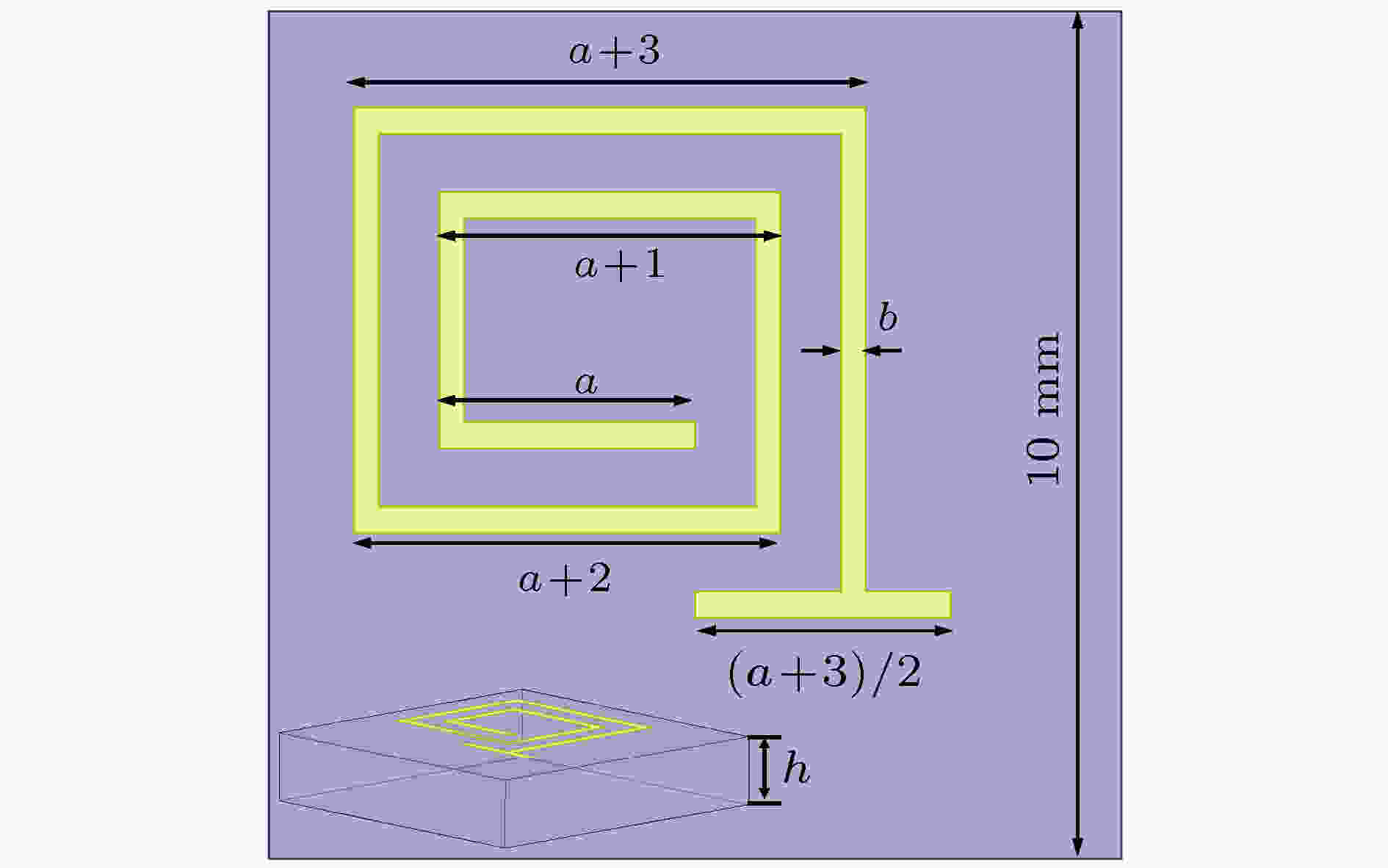
2019, 68 (9): 095201.
doi: 10.7498/aps.68.20181960
Abstract +
High-performance absorbing material can play an important role in electromagnetic compatibility, electromagnetic radiation protection, and anti-detection of special equipment. Combining traditional absorbing material with metamaterial is an important direction for developing absorbing material. The composite absorbing body based on the development of metamaterial has advantages of thin thickness, light weight, strong absorption, and adjustable absorption band, but the super material absorption body composed of single-sized metal pattern elements possesses generally strong absorption only for electromagnetic waves at a certain frequency. It is difficult to meet the requirement for wide frequency absorption in practical applications. In order to broaden the absorption bandwidth of metamatial, metal spiral-ring metasurface coated short carbon fiber absorber with enhanced microwave absorbing performance is proposed. The absorber is a two-dimensional structure formed by periodically arranging a large number of individual absorber units in the horizontal and vertical direction. In the HFSS simulation software, a " master-slave boundary condition” consisting of " master boundary” and " slave boundary” is provided. Under this boundary condition, the electric field between adjacent boundaries has a phase difference, which can be used to simulate an infinite array. The research results show that the obvious enhancement of both the absorption peak and bandwidth can be observed by embedding the double-layer spiral-ring metasurfaces. The increase of initial length of spiral-rings and thickness of absorber are beneficial to further enhancing the microwave absorption. The reflection loss from 9.2 GHz to 18.0 GHz are under –10 dB (the bandwidth reaches 8.8 GHz), and the peak of S11 is –14.4 dB. Besides, we find that the effective electromagnetic parameters and impedance of spiral-ring metasurface embedded microwave absorber present obvious resonant phenomenon at multi-frequencies by calculating S parameters. Furthermore, an equivalent circuit model regarding double-layer spiral-ring embedded absorber is established to reveal the attenuation mechanism of microwave energy. The resonant frequencies derived from this model are well accord with the simulated results. Thereby, the multi-electromagnetic resonant frequencies make the composite microwave absorber combined with double-layer metal spiral-ring and carbon fiber have microwave reflection loss in a wide bandwidth.
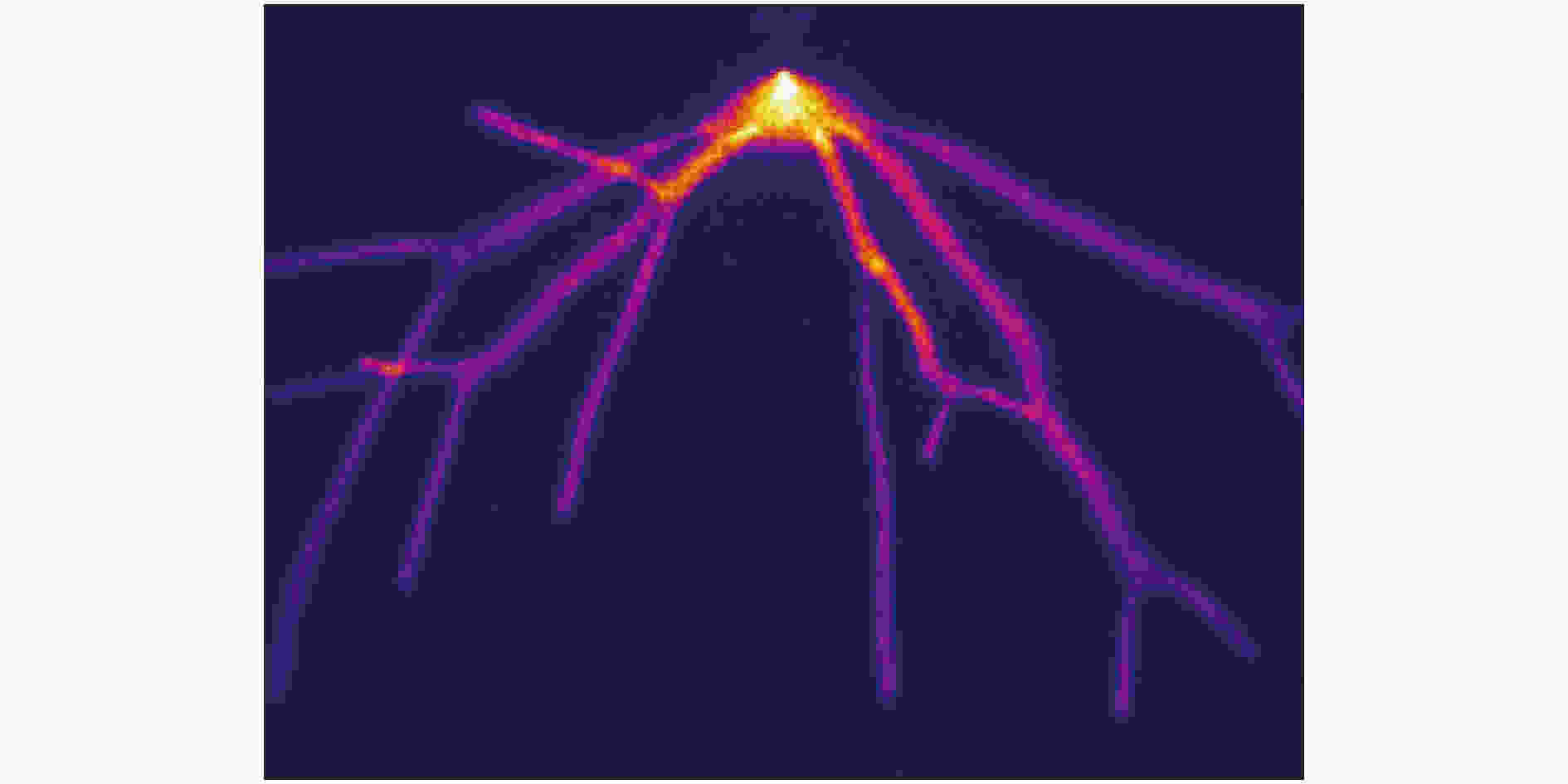
2019, 68 (9): 095202.
doi: 10.7498/aps.68.20190060
Abstract +
Streamer is a strong ionizing region which advances very quickly in gases, liquids and solids. Streamer is a low-temperature plasma, which produces a variety of chemically reactive substances efficiently. So, streamer discharge has been widely adopted in industry. Furthermore, streamer is the initial stage of electric breakdown in long air gap. Studying the streamer discharge characteristics and its mechanism is the basis of external insulation in power transmission systems.Streamer branching is a significant characteristic during its development. Lichtenberg figure is the first clear recording of the filamentary structure of streamers. One of acceptable explanations is that the random fluctuations of the electron density ahead of streamer trigger branching. Furthermore, photoionization provides the necessary free electrons for the development of positive streamers. The experimental results show that the branching characteristics are closely related to the photoionization rate in streamer head. The streamer shows higher possibility of branching if the photoionization rate decreases. Since previous experiment is indirect evidence of this deduction, we turn to numerical models to study the influence of photoionization rates on positive streamer branching in atmospheric air. A three-dimensional particle-in-cell model with Monte Carlo collision (PIC-MCC) scheme called Pamdi3D (Teunissen J, Ebert U 2016 Plasma Sources Sci. Technol. 25 044005) is employed in this paper. The development and branching of positive streamersin a millimeter-scale needle-plane gap are simulated at atmospheric pressure. Different streamer branching behaviors are investigated by artificially changing the nitrogen-oxygen ratio, the absorption cross section of oxygen, and the photoionization efficiency coefficient.The effects of different photoionization parameters are systematically studied. When the nitrogen-oxygen ratio, photon absorption cross section or photoionization efficiency coefficient are reduced, the streamer branching occurs earlier in three cases after reducing the photoionization rate. These results imply that the streamer shows higher possibility of branching if the photoionization rate decreases. When the streamer propagates in a non-uniform electric field region and the photoionization rate decreases to a certain value, it is believed that the seed electron distribution is more susceptible to random fluctuations. It will lead to instability in the space charge layer of streamer, thus causing the streamer to branch. Hence it is proposed that streamer branch will be triggered more easily if the photoionization rate in the streamer head decreases, in the case without considering other seed electron sources.
CONDENSED MATTER: STRUCTURAL, MECHANICAL, AND THERMAL PROPERTIES
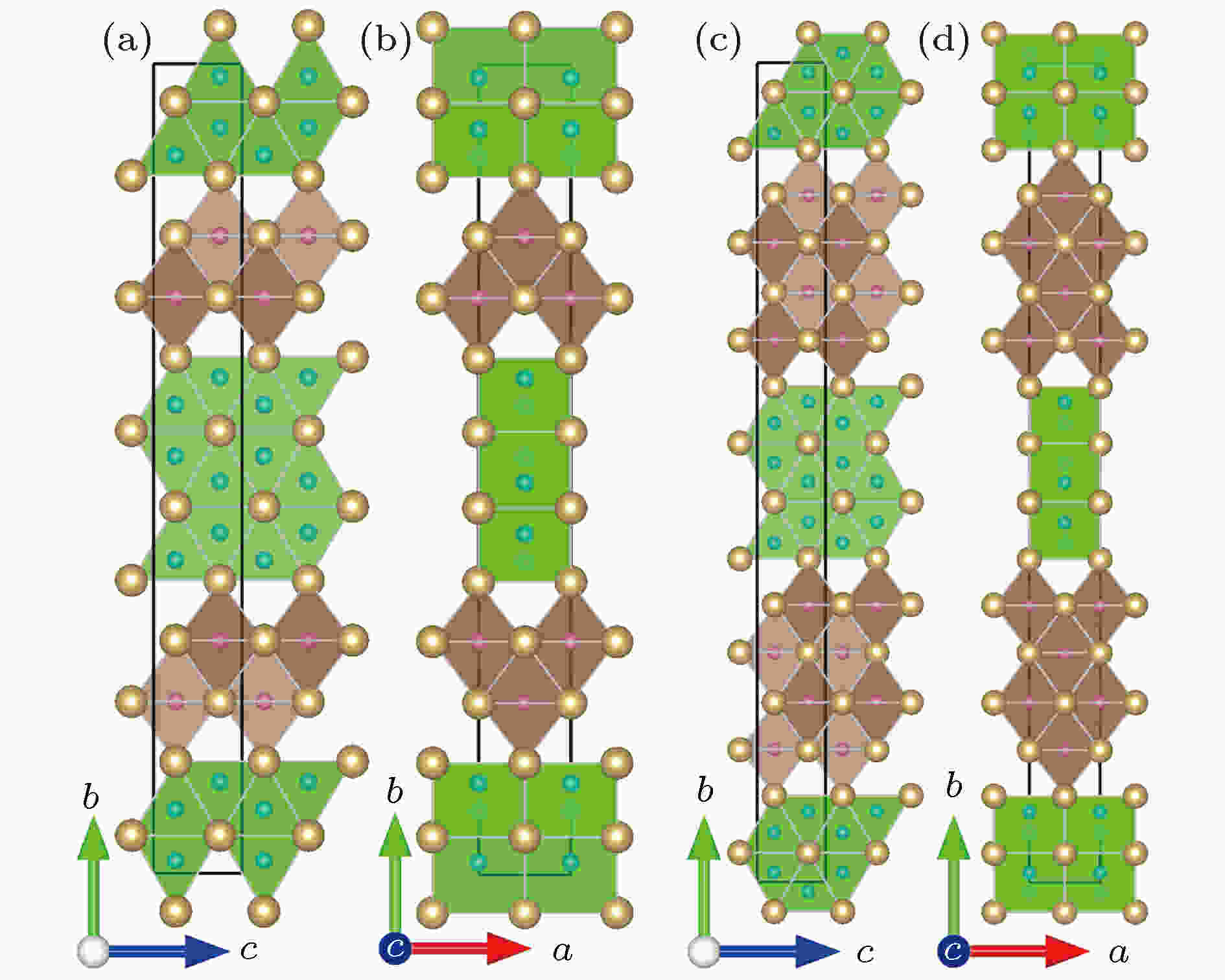
2019, 68 (9): 096201.
doi: 10.7498/aps.68.20190158
Abstract +
To search new hard or superhard materials in transition-metal light-element compounds is a current research focus. Most of the past researches focused on binary phases such as transition metal borides, carbides and nitrides, while the researches on ternary phases were relatively rare. The single crystals Nb3B3C and Nb4B3C2 were synthesized recently by using Al-Cu alloys as auxiliary metals and their structures were determined by Hillebrechtand Gebhardt. In the present paper, 29 TM3B3C and 29 TM4B3C2 configurations are constructed by TM atoms (TM = Sc to Zn, Y to Cd, Hf to Hg) replacing Nb atoms in the known Nb3B3C and Nb4B3C2 configuration. By calculating the formation energy from first-principles density functional theories, only 13 TM3B3C and 11 TM4B3C2 phases are stable compared with the three elemental substances of TM, boron and carbon. However compared with the most competing phases, only Ta3B3C, Nb3B3C and Nb4B3C2 phases are stable thermodynamically. The metastable Ta4B3C2 phase at 0 K becomes stable when temperature is higher than 250 K. Thus two new phases of Ta3B3C and Ta4B3C2 are uncovered to be stable thermodynamically. Global structure searches conducted by the popular USPEX and CALYPSO softwares prove the Ta3B3C and Ta4B3C2 phases to be the most favorable energetically. By calculating the phonon dispersion curves of the Ta3B3C and Ta4B3C2 phase, no imaginary phonon frequencies are observed in the whole Brillouin zone, which demonstrates the dynamical stability of the Ta3B3C and Ta4B3C2 phase. The calculated elastic constant of the Ta3B3C and Ta4B3C2 phases satisfy the criteria of mechanical stability, showing that the Ta3B3C and Ta4B3C2 phase are stable mechanically. The calculations of band structure and density of state show that the Ta3B3C and Ta4B3C2 phases are both conducting, which mainly arises from the d electrons of Ta atoms. The calculated bulk modulus and shear modulus of the Ta3B3C and Ta4B3C2 phases show their brittle nature. The hardness of Ta3B3C and Ta4B3C2 phase are nearly the same and calculated to be about 26 GPa by Chen’s and Tian’s models, which illuminates that the two phases are hard but not superhard.
INVITED REVIEW

INVITED REVIEW
2019, 68 (9): 096801.
doi: 10.7498/aps.68.20190279
Abstract +
Graphene is believed to have promising applications in many fields because of its unique properties. At present, graphene films are mainly prepared on Cu substrates by chemical vapor deposition. The graphene films prepared in this way need to be transferred to the target substrates for further applications, while the transfer process inevitably induces contamination on graphene, which affects the properties of graphene and the performance of devices. Therefore, how to reduce or avoid contamination and realize the clean transfer of graphene is an important topic for the development of graphene transfer technology, which is the major topic of this review. Here, firstly, the transfer techniques of graphene are briefly reviewed, which can be classified according to different rules. For example, it can be classified as direct transfer, with which graphene is directly stuck to the target substrate, and indirect transfer, with which graphene is indirectly transferred to the target substrate with a carrier film. According to the way of separating graphene and the growth substrate, it can also be classified as dissolving transfer, with which the substrate is dissolved by chemical etchant, and delaminating transfer, with which graphene is delaminated from the substrate. Then the origins of contamination are discussed followed with how contamination affects graphene properties. The main contaminations induced by transfer are ions from the etchant and electrolyte, undissolved metal or metal oxide particles, and organic residues from carrier films. Contaminations have a great influence on the electrical, thermal and optical properties of graphene. Then the up-to-date progress of techniques for clean transfer is reviewed, including modifying the cleaning process or using alternative etchant/electrolyte to remove or suppress metal contamination and annealing graphene or using alternative carrier films (e.g., more dissoluble materials) to remove or suppress organic residues. Finally, the challenges of clean transfer of graphene are summarized, and future research directions and opportunities are prospected. This review not only contributes to the research of graphene film transfer technology, but also has great reference value for the clean fabrication of the whole two-dimensional materials and devices.
CONDENSED MATTER: ELECTRONIC STRUCTURE, ELECTRICAL, MAGNETIC, AND OPTICAL PROPERTIES

2019, 68 (9): 097101.
doi: 10.7498/aps.68.20190020
Abstract +
Two-dimensional (2D) materials exhibit massive potential in research and development in the scientific world due to their unique electrical, optical, thermal and mechanical properties. Graphene is an earliest found two-dimensional material, which has many excellent properties, such as high carrier mobility and large surface area. However, single layer graphene has a zero band gap, which limits its response in electronic devices. Unlike graphene, the transition metal sulfides (TMDs) have various band structures and chemical compositions, which greatly compensate for the defect of zero gap in graphene. The WS2 is one of the 2D TMDs exhibiting a series of unique properties, such as strong spin-orbit coupling, band splitting and high nonlinear susceptibility, which make it possess many applications in semiconducting optoelectronics and micro/nano-electronics. The 2D semiconductors along with semimetallic graphene are seen as basic building blocks for a new generation of nanoelectronic devices. In this way, the artificially designed TMD heterostructure is a promising option for ultrathin photodetectors. There are few reports on the physical mechanism of carrier mobility and charge distribution at the interface of WS2/graphene heterostructure, by varying the interfacial distance of WS2/graphene heterostructure to investigate the effect on the electronic properties. Here in this work, the corresponding effects of interface cohesive interaction and electronic properties of WS2/graphene heterostructure are studied by first-principles method. The calculation results indicate that the lattice mismatch between monolayer WS2 and graphene is low, the equilibrium layer distance d of about 3.42 Å for the WS2/graphene heterostructure and a weak van der Waals interaction forms in interface. Further, by analyzing the energy band structures and the three-dimensional charge density difference of WS2/graphene, we can identify that at the interface of the WS2 layer there appears an obvious electron accumulation: positive charges are accumulated near to the graphene layer, showing that WS2 is an n-type semiconductor due to the combination with graphene. Furthermore, the total density of states and corresponding partial density of states of WS2/graphene heterostructure are investigated, and the results show that the valence band is composed of hybrid orbitals of W 5d and C 2p, whereas the conduction band is comprised of W 5d and S 3p orbitals, the orbital hybridization between W 5d and S 3p will cause photogenerated electrons to transfer easily from the internal W atoms to the external S atoms, thereby forming a build-in internal electric field from graphene to WS2. Finally, by varying the interfacial distance for analyzing the Schottky barrier transition, as the interfacial distance is changed greatly from 2.4 Å to 4.2 Å, the shape of the band changes slightly, however, the Fermi level descends relatively gradually, which can achieve the transition from a p-type Schottky contact to an n-type Schottky contact in the WS2/graphene. The plane-averaged charge density difference proves that the interfacial charge transfer and the Fermi level shift are the reasons for determining the Schottky barrier transition in the WS2/graphene heterostructure. Our studies may prove to be instrumental in the future design and fabrication of van der Waals based field effect transistors.
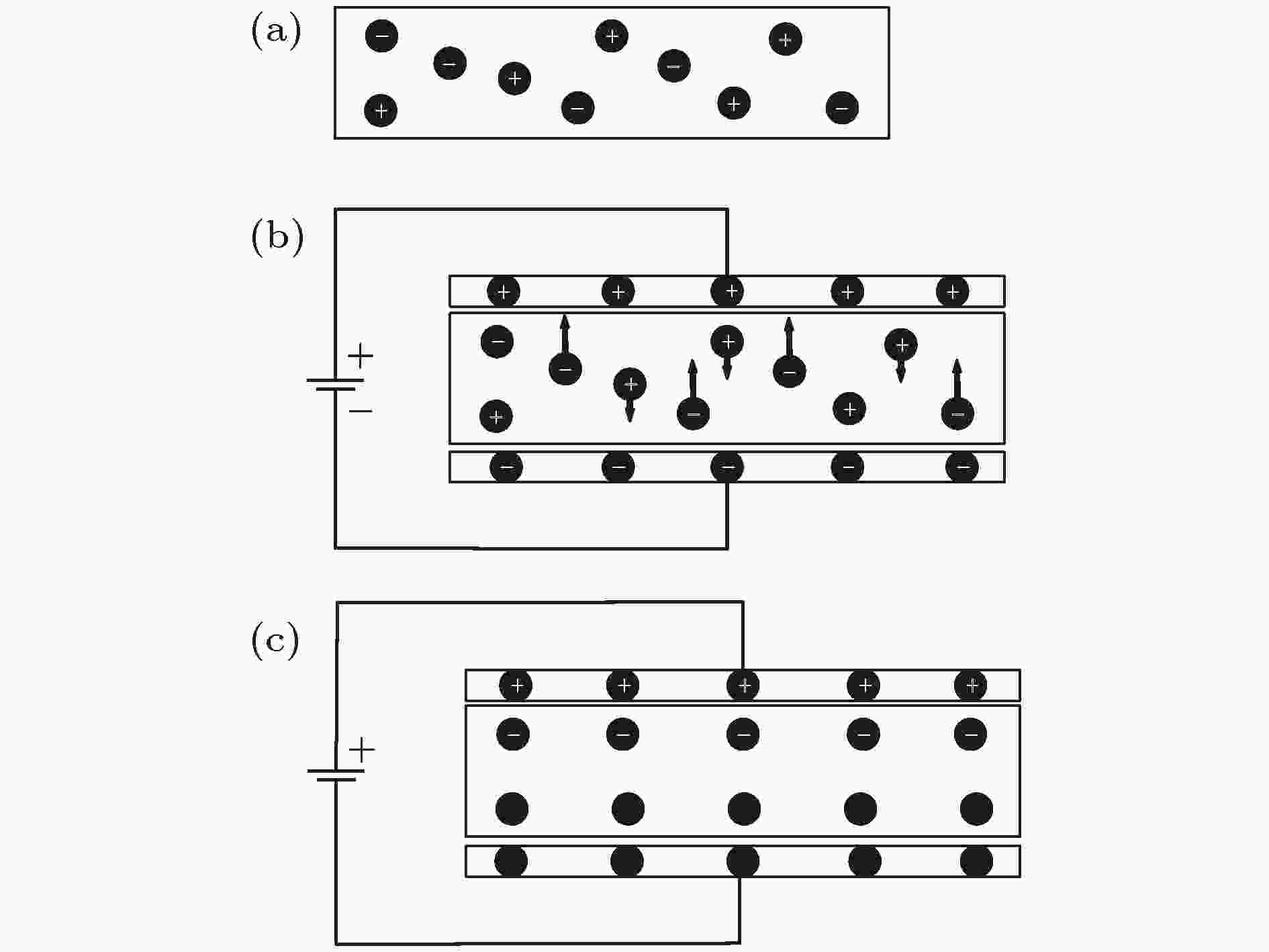
2019, 68 (9): 097301.
doi: 10.7498/aps.68.20190058
Abstract +
Graphene is a kind of two-dimensional material with high light transmittance, high mechanical properties and high carrier mobility. The energy band of graphene can be turned by doping and electric field. Researches on the application of graphene to electronic devices focused on field effect transistors. For improving the performance, one generally improves the fabrication process and device structure, but many researchers chose to change the material or structure of dielectric layer. Ion-gel is a kind of mixture of organic polymer mesh structure with good thermal stability and high dielectric value, prepared by macromolecule organic polymer and ionic salt electrolyte material. With the effect of electric field, cations and anions in ion-gel diffuse to form a double charge layer distribution with a charge layer on the surface of material. This capacitance characteristic is similar to that of traditional capacitor. In this paper, ion-gel (PVDF-[EMIM]TF2N) film is used as a dielectric layer material to prepare the bottom-gate graphene-based field effect transistor (GFET), which is compared with the GFET with SiO2 bottom-gate, according to electrical characteristic curves. The effect of the ion-gel film on the transconductance, switching ratio and Dirac voltage of the GFET are analyzed. The effect of the vacuum environment and temperature on the GFET performance with ion-gel film gate are also investigated. The results show that in the room-temperature environment, the switching ratio and transconductance of the ion-gel film gate GFET device increase to 6.95 and 3.68 × 10–2 mS, respectively, compared with those of the SiO2 gate GFET, while the Dirac voltage decreases to 1.3 V. The increase in transconductance and switching ratio of ion-gel film gate GFETs are mainly due to the high capacitance of ion-gel film compared with those of conventional SiO2 gate dielectrics. There will be more carriers inside the graphene while in the carrier accumulation region of GFET transfer characteristic curve, which makes graphene more conductive. The Dirac voltage of ion-gel film gate GFET can be reduced to 0.4 V in the vacuum environment; as the temperature increases, the transconductance of GFET can increase up to 6.11×10–2 mS. The results indicate that the ion-gel film-based graphene field effect transistor shows good electrical properties in serving as high dielectric constant organic dielectric materials.
INTERDISCIPLINARY PHYSICS AND RELATED AREAS OF SCIENCE AND TECHNOLOGY

2019, 68 (9): 098101.
doi: 10.7498/aps.68.20190133
Abstract +
As is well known, diamond is extensively used in many fields, because of its excellent properties, such as its hardness, high thermal conductivity, high electron and hole mobility, high breakdown field strength and large band gap (5.4 eV). However, its application in semiconductor area needs to be further understood, because it is irreplaceable by conventional semiconductor materials, especially in the extreme working conditions. Furthermore, the preparation of n-type diamond semiconductors is still an unsolved problem. The reason is that an effective donor element has not yet been found. Recently, both the theoretical and experimental studies show that it is difficult to obtain n-type diamond semiconductor with excellent properties by doping single element in the synthetic system. In this paper, diamond single crystals co-doped with B and S are successfully synthesized in FeNiMnCo-C system at a pressure of 6.5 GPa and temperature ranging from 1280 ℃ to 1300 ℃, by using temperature gradient method. The impurity defects in the synthesized diamond single crystals are characterized by Fourier infrared absorption spectra and the results indicate that the corresponding characteristic absorption peaks of B and S are located at 1298 cm–1 and 847 cm–1, respectively. Furthermore, the absorption attributed to B-S group is not detected. The N concentration of the synthesized diamond crystals decreases to 195 ppm, resulting from the incorporation of B and S impurities into the diamond lattices. Additionally, the electrical properties of the typical diamond single crystals are measured in virtue of Hall effects at room temperature. The measurement results display that the electrical conductivity of the diamond doped with B is obviously enhanced, resulting from the involvement of the S when B addition amount is fixed in the synthesis system. Hall mobility of the corresponding diamond crystals increases from 12.5 cm–2·V–1·s–1 to 760.87 cm–2·V–1·s–1. And then, the relative proportion of S and B will determine the p/n properties of the obtained diamond. In order to further study the electrical properties of diamond, first-principles calculations are adopted and the theoretical calculation results show that the impurity elements involved in the obtained diamond can affect the band structures of the synthetic diamond crystals, which is consistent with the experimental result.
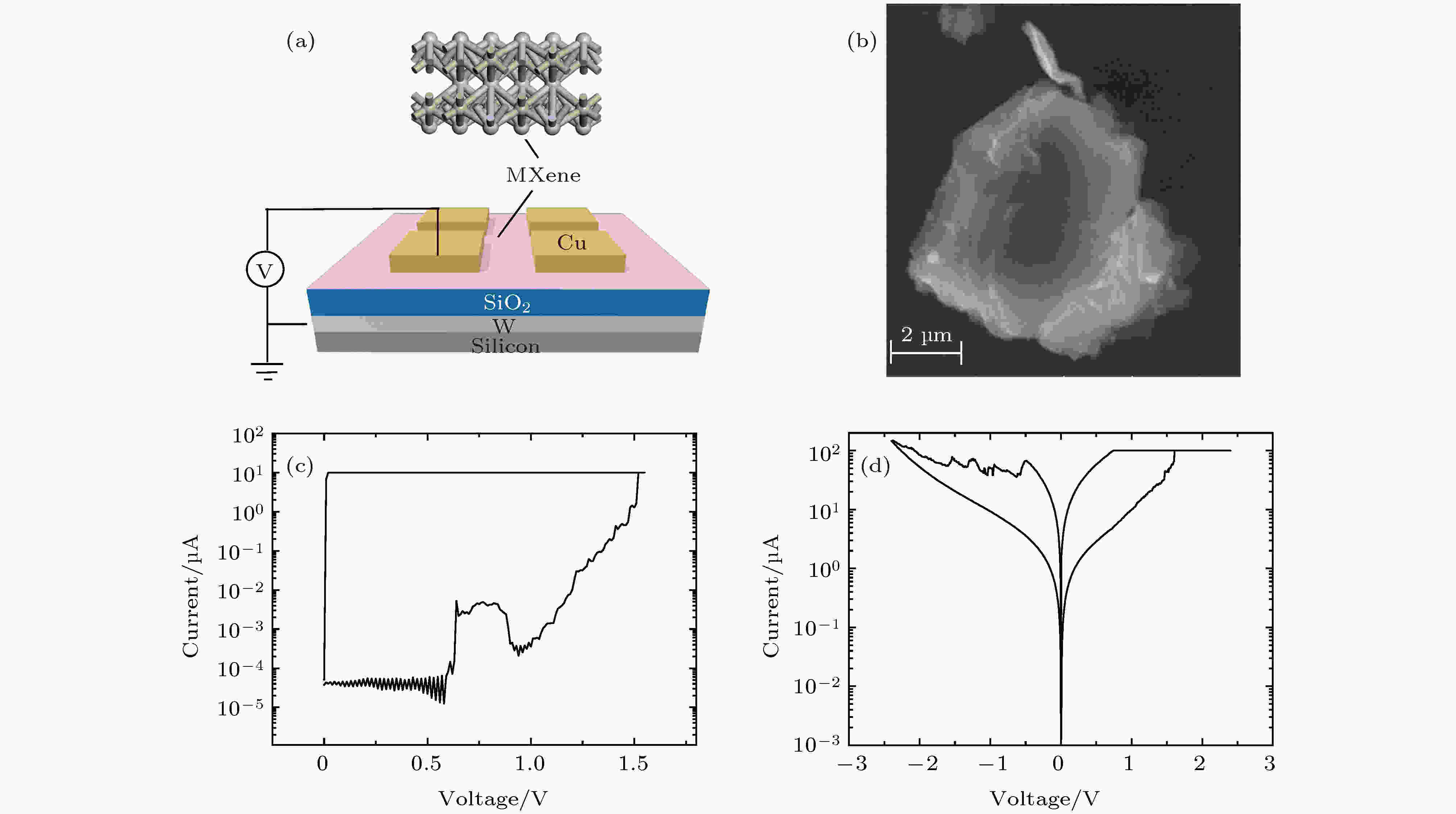
EDITOR'S SUGGESTION
2019, 68 (9): 098501.
doi: 10.7498/aps.68.20182306
Abstract +
Compared with conventional computation relying on the von Neumann architecture, brain-inspired computing has shown superior strength in various cognitive tasks. It has been generally accepted that information in the brain is represented and formed by vastly interconnected synapses. So the physical implementation of electronic synaptic devices is crucial to the development of brain-based computing systems. Among a large number of electronic synaptic devices, the memristors have attracted significant attention due to its simple structure and similarities to biological synapses. In this work, we first use two-dimensional material MXene as a resistive material and fabricate an electronic synapse based on a Cu/MXene/SiO2/W memristor. By using the unique properties of MXene, the conductance of the memristor can be modulated by the accumulation or reflux of Cu2+ at the physical switching layer, which can vividly simulate the mechanism of bio-synapses. Experimental results show that the Cu/MXene/SiO2/W memristor not only achieves stable bipolar analog resistance switching but also shows excellent long-term and short-term synaptic behaviors, including paired-pulse facilitation (PPF) and long-term potential/depression. By adjusting the pulse interval, the PPF index will change accordingly. In a biological system, the short-term plasticity is considered to be the key point for performing computational functions while the long-term plasticity is believed to underpin learning and memory functions. This work indicates that Cu/MXene/SiO2/W memristor with both long-term and short-term plasticity will have great application prospects for brain-inspired intelligence in the future.
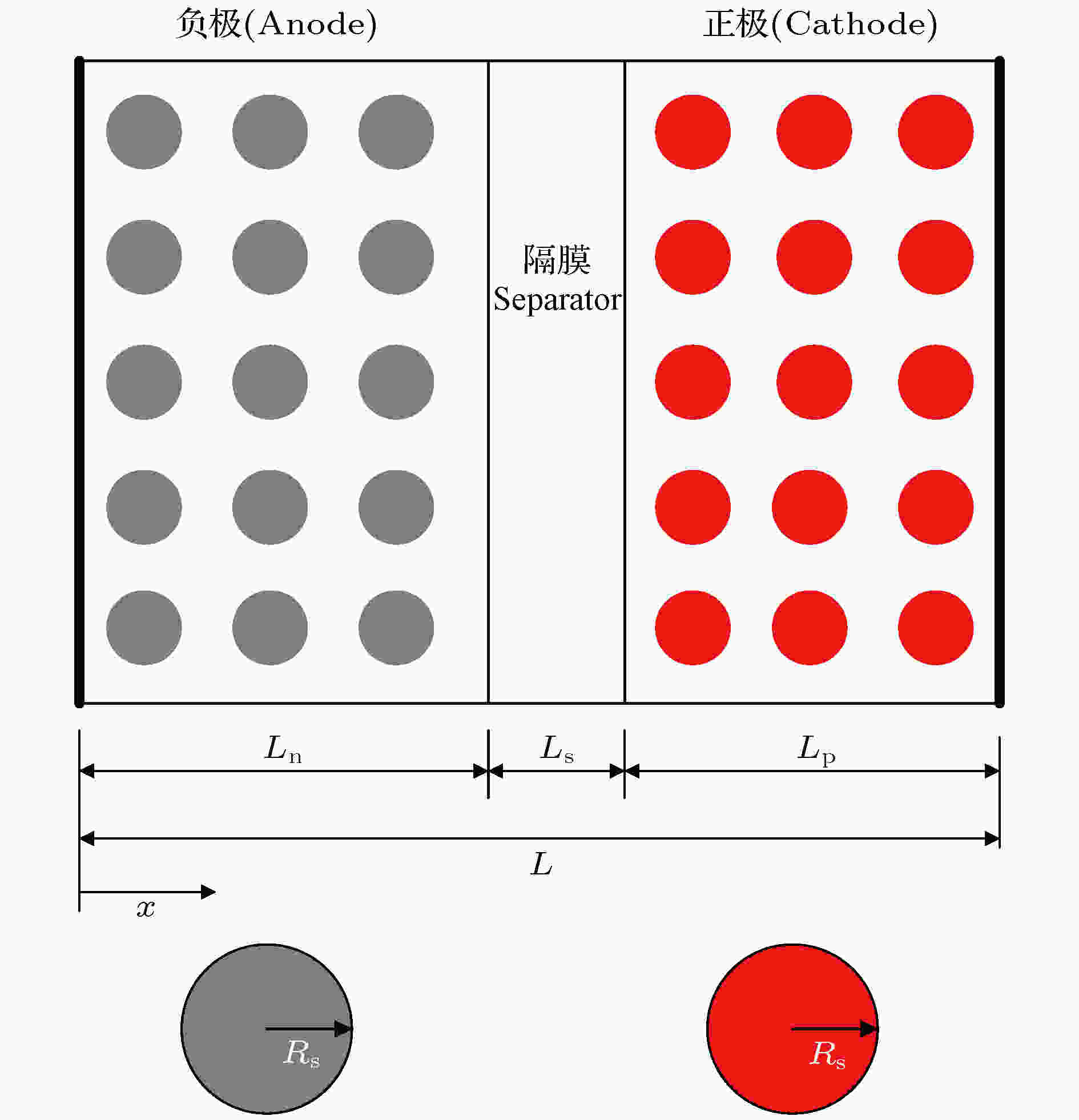
2019, 68 (9): 098801.
doi: 10.7498/aps.68.20190159
Abstract +
The pseudo-two-dimensional (P2D) model is the most widely used electrochemical model for lithium-ion batteries. Because of the complexity and the difficulty in using the complete P2D model, many simplified P2D models, such as the single particle model (SP model) and the parabolic profile approximation model (PP model), have been proposed. However, the using of the SP model can cause a large amount of precision to lose in its simplified process, while the PP model has a high complexity. In this paper, we propose a liquid phase simplification P2D (LSP2D) model. The using of the LSP2D model has a small precision loss and a relatively low complexity. The LSP2D model is based on the electrochemical average kinetics of the lithium ion battery. We first simplify the terminal voltage into an equation containing only the solid phase concentration cs and the liquid phase concentration ce. Then we use the partial differential equation to represent the solid phase concentration cs and the liquid phase concentration ce, and then obtain a final model. The simulation environment is based on COMSOL, and the simulation results show that when the discharge rate is 1C, the estimation accuracy and speed from the LSP2D model are similar to those from the SP model. But when the discharge rate is 3C, the estimation time from the LSP2D model is reduced by 99.73% compared with that from the P2D model, and the estimation accuracy is greatly improved compared with the estimation accuracy from the SP model.


















